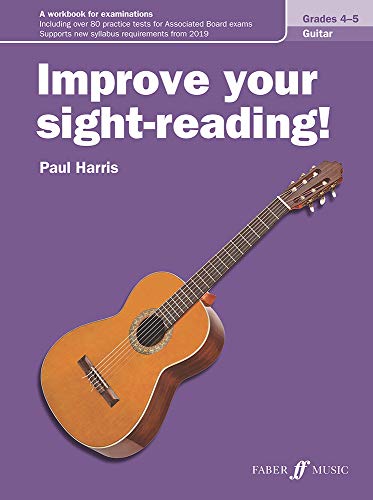
These books are packed with tests directly related to ABRSM's current guitar syllabus (published in 2019). There is no unnecessary padding, just a lot of musical examples and good precise advice. Paul Harris is very well known, though probably less so in the world of fretted strings. Guitar tutors will be pleased to see that this respected author has used help and advice from others, including Hugh Millington, for guitar expertise.
Like its author, this series is well established with a format familiar to many. In the Grades 1-3 book, four stages for each grade are set out in a contents list, making it very clear to the tutor and pupil what is covered and which new subjects are introduced at each step. This reference allows the pupil to focus upon individual areas of sight-reading practice without wasting time on aspects they have already mastered. A lucid single-page introduction explains how to use the book, with succinct advice.
Of over 150 tests here, separate exercises for rhythm and melody lead to fuller pieces with the sort of questions any sight-reader should ask (and answer) themselves before attempting to play. Following this is a set of examples entitled ‘Going Solo!’, the inference being that the pupil is on their own at this stage and must detect what they need to know before performing each piece.
There is mild creativity in each stage, which is encouraging, as well as invitations to take steps towards some gentle improvisation and composition, which have been essential and effective elements in my teaching over the last 45 years.
A page of golden rules gives five common-sense pointers as a checklist, as well as six aims to keep in mind while performing, and a short paragraph wisely reminding the pupil to take full and proper advantage of the time to look at the piece before playing it.
Each stage contains excellent advice (usually a sentence or two, sometimes a short list of points to consider or remember) that will help not only with reading at sight, but also with performing effectively, especially under pressurised scrutiny such as in an examination. ‘Always remember to count two bars in’, for example, will calm the nerves, focus attention and give the student a chance to set the appropriate tempo and get a feel for the piece.
Of course, the nature of the count-in itself is vitally important. This is often overlooked: I always advise my tutor students to ask their pupils to demonstrate their count-in procedure out loud, so that the teacher can gain insight into their understanding of timing. Hearing a student count in is an enlightening (and sometimes frightening) experience. Putting issues right before the piece begins makes a huge difference to both musician and music.
An exploration of keys and simple performance directions, in either Italian or English, forms part of the learning curve. Later in the book, light-hearted phrases (nothing too Percy Grainger) expand interpretation possibilities. The last-page pieces are all ‘With a touch of…’, allowing handy discussion points, although the so-called Hendrix piece displays no familiarity with his music.
At Grade 2, ties are introduced. Apart from two mid-bar examples in the rhythmic exercises, all ties are across a bar line, including in the Grade 3 section where they become extremely scarce. Ties are scattered throughout the Grades 4-5 book where they are distinctly more idiomatic.


The volume for Grades 4-5 is laid out along similar lines: over 80 practice tests in four stages for Grade 4, while Grade 5 has three stages. Pieces are very diatonic with occasional accidentals – very little that will stop a sight-reader in their tracks. Most lack inspiring titles (such as those featured in ABRSM's own Guitar Specimen Sight-Reading Tests publication, which makes the activity feel musically realistic) so the pupil here is perhaps more aware they are playing a preparatory test. In the final section of Grade 4, Spanish and Latin flavours are introduced, with helpful dance titles also indicating regional clues. Printing and presentation are both excellent, as we would expect from Faber Music.
There are significant others in this arena. John Kember's more weighty pair of books contain clever compositions that are a joy to play; and Chaz Hart's trio of tried-and-tested volumes has insightful writing for the instrument, showing intimate knowledge of position work and fingering. The Improve your sight reading! volumes complement these with the advantage of relating to grades. I look forward to the offering for Grades 6-8.




